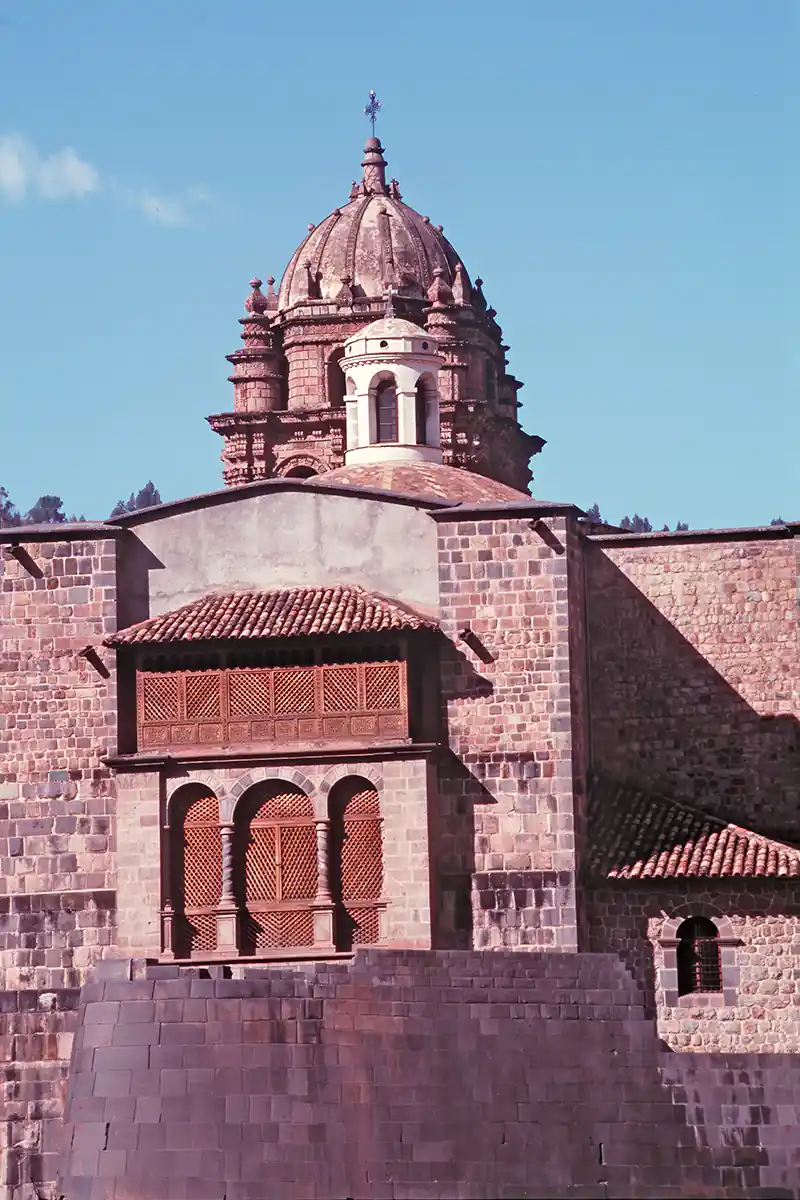Church of Santo Domingo and Coricancha Temple, Cuzco
One of the oldest continuously inhabited cities in the western hemisphere, Cuzco was the political and religious capital of the Inca Empire of Tawantinsuyu, meaning 'Four Quarters of the Earth.' The original Quechua name of the city was Qosqo, meaning 'navel' or 'center,' but the early Spanish conquerors changed the name to Cuzco, meaning a hypocrite, humpback, or small dog. In 1990, the local government voted to reinstate the original name. Situated at 11,150 feet, Cuzco was laid out on a grid plan in the shape of a puma, a sacred mountain lion. The pre-Inca site of Sacsayhuaman, on a plateau near the city's northern edge, forms the head of the puma, and the Coricancha temple forms the center of the grid.
The Coricancha (sometimes spelled Qoricancha) was the centerpiece of a vast astronomical observatory and calendrical device for precisely calculating precessional movement. The Inca took over an earlier sacred site at the center of the city, upon which they constructed their primary temple and astronomical observatory. Emanating from the temple were forty lines (some sources say 42) called ceques, running arrow-straight for hundreds of miles and pointing toward significant celestial points on the horizon. Between 328 and 365, huacas or shrines were situated along these ceques. Four of the ceques represented the four intercardinal roads to the four quarters of Tawantinsuyu, others pointed to the equinox and solstice points, and still others to the heliacal rise positions of different stars and constellations significant to the Inca. The Inca also used the Coricancha in conjunction with standing stones called sucancas positioned on the horizon of nearby mountains to determine the dates of the solstices and equinoxes and monitor the passage of precessional time. The great temple also incorporates a prominent solar alignment using a nearby peak called Pachatusan as a sightline for the June solstice. The elliptical exterior wall of the temple may have served as a model of the celestial ecliptic.
The Coricancha temple (literally, "the corral of gold") was primarily dedicated to Viracocha, the creator god, and Inti, the Sun god. The Coricancha also had subsidiary shrines to the Moon, Venus, the Pleiades, and various weather deities. Additionally, many religious icons of conquered peoples were brought to Cusco, partly in homage and partly as hostages. Reports by the first Spanish who entered Cuzco tell that over 4000 priests served the Coricancha, that ceremonies were conducted around the clock, and that the temple was fabulous beyond belief. The wonderfully carved granite walls of the temple were covered with more than 700 sheets of pure gold, weighing around two kilograms each; the spacious courtyard was filled with life-size sculptures of animals and a field of corn, all fashioned from pure gold; the floors of the temple were themselves covered in solid gold; and facing the rising sun was a massive golden image of the sun encrusted with emeralds and other precious stones. All of this golden artwork was quickly stolen and melted down by the Spanish conquistadors, led by Francisco Pizzaro, who then built a church of Santo Domingo on the temple's foundations. At the center of the Coricancha, marking a place known as Cuzco Cara Urumi (the 'Uncovered Navel Stone') is an octagonal stone coffer that was once covered with 55 kilograms of pure gold. Major earthquakes have severely damaged the church, but the Inca stone walls, built out of huge, tightly interlocking stone blocks, still testify to their superb architectural skills and sophisticated stone masonry.

Martin Gray is a cultural anthropologist, writer and photographer specializing in the study of pilgrimage traditions and sacred sites around the world. During a 40 year period he has visited more than 2000 pilgrimage places in 160 countries. The World Pilgrimage Guide at sacredsites.com is the most comprehensive source of information on this subject.

